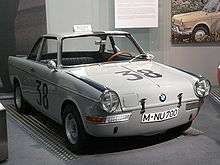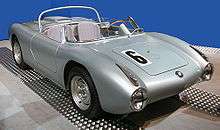BMW 700
| BMW 700 | |
|---|---|
 BMW 700 saloon | |
| Overview | |
| Manufacturer | BMW |
| Also called | BMW LS |
| Production |
1959–1965 188,211 built[1] Saloon: 154,557 Coupé: 31,062 Convertible: 2,592 |
| Body and chassis | |
| Body style |
2-door saloon 2-door coupe 2-door convertible |
| Layout | RR layout |
| Powertrain | |
| Engine | 697 cc Flat twin |
| Transmission | 4 speed manual |
| Dimensions | |
| Wheelbase |
2,120 mm (83 in) LS: 2,280 mm (90 in) [2] |
| Length |
3,540 mm (139 in) LS: 3,860 mm (152 in) |
| Width | 1,480 mm (58 in) |
| Height | 1,270 mm (50 in)−1,360 mm (54 in) |
| Curb weight | 640 kg (1,410 lb)−690 kg (1,520 lb) |
| Chronology | |
| Predecessor | BMW 600 |
| Successor | Mini (BMW) |
The BMW 700 is a small rear-engined car which was produced by BMW in various models from August 1959 to November 1965. It was the first BMW automobile with a monocoque structure. The 700 was a sales success at a time when BMW was close to financial ruin.[3] The 700 was also successful in its class in motorsport, both in its stock form and as the basis of a racing special called the 700RS.
More than 188,000 were sold before production ended in November 1965. Upon discontinuing the 700, BMW left the economy car market and did not return until 2002 with the Mini.
Concept, design, and engineering
Wolfgang Denzel, the distributor of BMW cars in Austria, commissioned Giovanni Michelotti to prepare concept sketches based on a lengthened BMW 600 chassis.[4] In January 1958, Denzel was awarded a development contract for the 700. Denzel presented a prototype to BMW's management in July 1958.[5] The concept, a 2-door coupe with a slanted roof, was generally well received, but objections were raised about the limited passenger space.[4][5] BMW decided to produce two versions, the coupe, and a 2-door sedan with a taller, longer roof.[4]
The engineer responsible for the chassis and suspension was Willy Black, who had designed and engineered the 600. The drivetrain and suspension were similar to those of the 600, with a rear mounted flat-twin engine powering the rear wheels, leading arm suspension at the front, and semi trailing arm suspension at the rear. The 700 used a steel monocoque structure, and was the first BMW automobile to do so.[4]
The engine was an enlarged version of that used in the R67 motorcycle and the 600. With a bore of 78 millimetres (3.1 in) and 73 millimetres (2.9 in) of stroke, the engine displaced 697 cubic centimetres (42.5 cu in). The engine originally used a single Solex 34PCI carburetor and had a compression ratio of 7.5:1, resulting in a power output of 30 horsepower (22 kW).[4]
Reception
The coupe and saloon versions of the 700 were shown at the 1959 Frankfurt Motor Show.[6] After the show, BMW received 25,000 orders for 700s.[7] Production of the BMW 700 Coupe began in August 1959, with the saloon version following in December.[4]
The large number of orders was welcome news for BMW, which was in a financial crisis. In December 1959, shareholders blocked a proposal by BMW's supervisory board to merge BMW into Daimler-Benz.[8] The subsequent heavy investment in BMW by Harald Quandt has been attributed in part to the success of the 700.[7][9]
By April 1960, production of the 700 was at 155 cars per day.[4] 188,211 BMW 700s were built in five years of production.[1]
Development
The first variant of the 700 to appear after the original coupe and saloon was the 700 Sport in August 1960. Available only as a coupe, the Sport used an uprated engine with a pair of Solex carburetors and a 9.0:1 compression ratio. This brought the power output to 40 horsepower (30 kW). The Sport also had a rear anti-roll bar.[4] A ribbed oil pan was used to reduce the oil temperature of the more powerful engine.[10] The 700 Sport was renamed the 700 CS in 1963.[4]
The 700 Cabriolet was introduced shortly after the 700 Sport, and was available only with the Sport's 40 horsepower engine.. The convertible body was made by Karosserie Baur of Stuttgart.[4][11] 2,592 convertibles were built.[4]
A Saxomat semi-automatic transmission was offered as an option on 700s from September 1960.[10]
The 700 Luxus replaced the original saloon in 1962.[4] The wheelbase had been extended by 16 centimetres (6.3 in).[12] The 700 LS, a simplified Luxus with a lower price, was introduced in 1963.[10]
In February 1963, the size of the inlet valves in the 700's base engine was increased. This increased power to 32 horsepower (24 kW).[12]
The final development of the 700 was the 700 LS Coupe of 1964. This was a long-wheelbase coupe with the Sport engine. 1,730 LS Coupes were built.[4]
Production of the BMW 700 ended in November 1965. By that time, the successful New Class cars had established themselves in the marketplace. High demand for these larger cars with larger profit margins led BMW to stop making economy cars.[4] BMW eventually returned to the economy car market in 2002 with the Mini.[13]
An attempt to transfer the rights to body production and export markets of the 700 to Autocars Co. in Israel in 1965 fell through. E. Illin Industries had earlier tried to start an enterprise in assembling 700s in Israel, which resulted in four 700s being assembled there in April 1963.[14]
-

BMW 700 saloon
-

BMW 700 LS Coupe
-
BMW 700 Cabrio
Motorsport

Several racing drivers competed in BMW 700s. Hans Stuck won the 1960 German Hillclimb Championship in a 700. Stuck and Sepp Grieger drove another to a class victory at the 1960 Hockenheim 12-hour race. Walter Schneider and Leo Levine raced a 700 to a class victory at the Nürburgring six-hour touring car race in 1960. Schneider went on to win the 1961 German saloon car title. Also in 1961, a BMW 700 won its class at Monza, beating their greatest rival Abarth on their home ground.[15] Other drivers competing in 700s included Jacky Ickx, Hubert Hahne, and Alpina founder Burkard Bovensiepen.[16]

700 RS
The 700 RS was a sports racing car based on the 700. It had a tubular frame chassis, special, lightweight, aerodynamic bodywork, and a double overhead camshaft engine tuned to 70 PS (51 kW; 69 hp).[17] Hans Stuck campaigned the 700RS with success.[16]
References
- Citations
- 1 2 Oswald, Werner (2001). Deutsche Autos 1945-1990, Band 4 (1. ed.). Stuttgart: Motorbuch Verlag. ISBN 3-613-02131-5.
- ↑ Gloor, Roger (2007). Alle Autos der 50er Jahre 1945 - 1960 (1. ed.). Stuttgart: Motorbuch Verlag. ISBN 978-3-613-02808-1.
- ↑ Claus Jacobi (managing editor), Rudolf Augstein (proprietor & former managing editor) (13 May 1959). "BMW: Das rettende Modell". SPIEGEL-ONLINE. p. 28. Retrieved 2013-05-20.
- 1 2 3 4 5 6 7 8 9 10 11 12 13 14 BMW - Bavaria's Driving Machines, Norbye, pp. 124-125
- 1 2 "History: The 700 Story, p.1". BMW700.net. 1958-07-30. Archived from the original on 2011-07-23. Retrieved 2012-08-11.
- ↑ "History: The 700 Story, p.2". BMW700.net. 1958-11-21. Archived from the original on 2011-07-23. Retrieved 2012-08-11.
- 1 2 "History: The 700 Story, p.3". BMW700.net. Archived from the original on 2011-07-23. Retrieved 2012-08-11.
- ↑ BMW - Bavaria's Driving Machines, Norbye, p. 132
- ↑ Roberts, Andrew (2007-09-25). "BMW 700". The Independent. Retrieved 2012-08-11.
- 1 2 3 "History: The 700 Story, p.4". BMW700.net. Archived from the original on 2011-07-23. Retrieved 2012-08-11.
- ↑ Deutsche Autos 1945-1990, Band 4, Oswald, p.184
- 1 2 "History: The 700 Story, p.5". BMW700.net. Archived from the original on 2011-07-23. Retrieved 2012-08-11.
- ↑ The Ultimate History of BMW, Noakes, pp.172-174
- ↑ "BMW 700, the Haifa version". The Israel Motor Industry. Retrieved 2012-08-11.
- ↑ Rombauts, Walter, ed. (1979-09-15). "Hoe een dubbeltje rollen kan" [How the penny might drop]. Keesings Auto Magazine (in Flemish). Antwerp, Belgium. 2 (17): 59.
- 1 2 Noakes, The Ultimate History of BMW, pp. 60-61
- ↑ "700 RS". Ultimate Car Page. 2009-04-17. Archived from the original on 2011-06-12. Retrieved 2012-08-11.
- Sources
- "BMW700.net - History - The 700 Story". BMW700.net. Retrieved 2010-07-01.
- Gloor, Roger (2007). Alle Autos der 50er Jahre 1945 - 1960 (1. ed.). Stuttgart: Motorbuch Verlag. ISBN 978-3-613-02808-1.
- Melissen, Pieter (2009-04-17). "Bmw 700 rs". Ultimatecarpage.com. Wouter Melissen. Retrieved 2010-06-23.
- Norbye, Jan P. (1984). BMW - Bavaria's Driving Machines. Skokie, IL, USA: Publications International. pp. 124–125, 132. ISBN 0-517-42464-9.
- Noakes, Andrew (2005). "Chapter 4: Rescue and Revival 1959-72". The Ultimate History of BMW. Bath, UK: Parragon Publishing. pp. 60–61. ISBN 1-4054-5316-8.
- Oswald, Werner (2001). Deutsche Autos 1945-1990, Band 4 (1. ed.). Stuttgart: Motorbuch Verlag. p. 184. ISBN 3-613-02131-5.
- Roberts, Andrew (25 September 2007). "BMW 700". The Independent. London, UK: Independent Print. paragraph 6. Retrieved 2010-06-24.
BMW was saved from bankruptcy in the late Fifties by this Herald lookalike
- IsraelMotorIndustry.org. "BMW 700, the Haifa version". Retrieved 2011-09-10.
External links
| Wikimedia Commons has media related to BMW 700. |
| Wikimedia Commons has media related to BMW 700 RS. |
| « previous — BMW road car timeline, 1950s–1980s — next » | |||||||||||||||||||||||||||||||||||||||||
|---|---|---|---|---|---|---|---|---|---|---|---|---|---|---|---|---|---|---|---|---|---|---|---|---|---|---|---|---|---|---|---|---|---|---|---|---|---|---|---|---|---|
| Type | Series | 1950s | 1960s | 1970s | 1980s | ||||||||||||||||||||||||||||||||||||
| 0 | 1 | 2 | 3 | 4 | 5 | 6 | 7 | 8 | 9 | 0 | 1 | 2 | 3 | 4 | 5 | 6 | 7 | 8 | 9 | 0 | 1 | 2 | 3 | 4 | 5 | 6 | 7 | 8 | 9 | 0 | 1 | 2 | 3 | 4 | 5 | 6 | 7 | 8 | 9 | ||
| Microcar | Isetta 250/300 | ||||||||||||||||||||||||||||||||||||||||
| Small family car | 600 | LS/700 | |||||||||||||||||||||||||||||||||||||||
| Compact exec | 3 Series | 02 Series | E21 | E30 | |||||||||||||||||||||||||||||||||||||
| Executive | 5 Series | 340/340-2* | New Class sedans | E12 | E28 | E34 | |||||||||||||||||||||||||||||||||||
| Luxury | 7 Series | 501/502 | E3 | E23 | E32 | ||||||||||||||||||||||||||||||||||||
| Coupé | 1600GT | ||||||||||||||||||||||||||||||||||||||||
| 6 Series | 327* | 503 | 3200 CS | New Class coupes | E9 | E24 | |||||||||||||||||||||||||||||||||||
| Roadster | Z Series | 507 | Z1 | ||||||||||||||||||||||||||||||||||||||
| Sports car/GT | M1, 8 Series | E26 | E31 | ||||||||||||||||||||||||||||||||||||||
| *made in East Germany as EMW | |||||||||||||||||||||||||||||||||||||||||